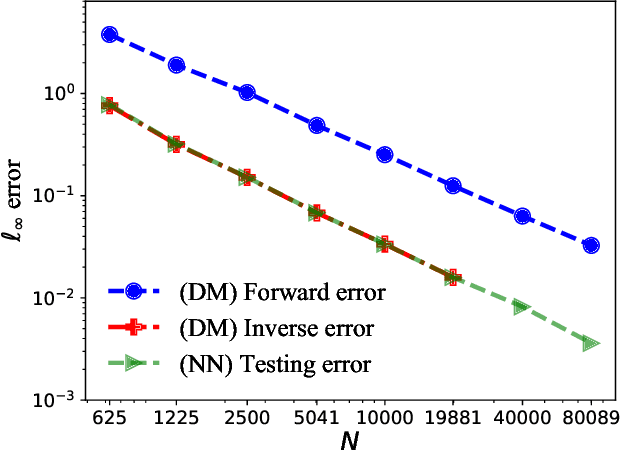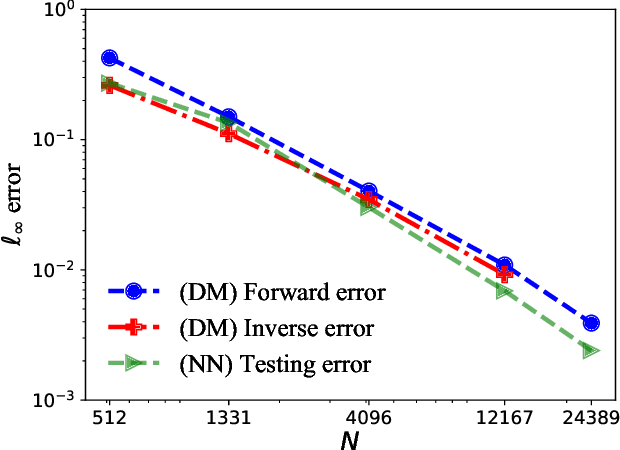John Harlim
Learning solution operator of dynamical systems with diffusion maps kernel ridge regression
Dec 19, 2025Abstract:Many scientific and engineering systems exhibit complex nonlinear dynamics that are difficult to predict accurately over long time horizons. Although data-driven models have shown promise, their performance often deteriorates when the geometric structures governing long-term behavior are unknown or poorly represented. We demonstrate that a simple kernel ridge regression (KRR) framework, when combined with a dynamics-aware validation strategy, provides a strong baseline for long-term prediction of complex dynamical systems. By employing a data-driven kernel derived from diffusion maps, the proposed Diffusion Maps Kernel Ridge Regression (DM-KRR) method implicitly adapts to the intrinsic geometry of the system's invariant set, without requiring explicit manifold reconstruction or attractor modeling, procedures that often limit predictive performance. Across a broad range of systems, including smooth manifolds, chaotic attractors, and high-dimensional spatiotemporal flows, DM-KRR consistently outperforms state-of-the-art random feature, neural-network and operator-learning methods in both accuracy and data efficiency. These findings underscore that long-term predictive skill depends not only on model expressiveness, but critically on respecting the geometric constraints encoded in the data through dynamically consistent model selection. Together, simplicity, geometry awareness, and strong empirical performance point to a promising path for reliable and efficient learning of complex dynamical systems.
A Weak Penalty Neural ODE for Learning Chaotic Dynamics from Noisy Time Series
Nov 10, 2025Abstract:Accurate forecasting of complex high-dimensional dynamical systems from observational data is essential for several applications across science and engineering. A key challenge, however, is that real-world measurements are often corrupted by noise, which severely degrades the performance of data-driven models. Particularly, in chaotic dynamical systems, where small errors amplify rapidly, it is challenging to identify a data-driven model from noisy data that achieves short-term accuracy while preserving long-term invariant properties. In this paper, we propose the use of the weak formulation as a complementary approach to the classical strong formulation of data-driven time-series forecasting models. Specifically, we focus on the neural ordinary differential equation (NODE) architecture. Unlike the standard strong formulation, which relies on the discretization of the NODE followed by optimization, the weak formulation constrains the model using a set of integrated residuals over temporal subdomains. While such a formulation yields an effective NODE model, we discover that the performance of a NODE can be further enhanced by employing this weak formulation as a penalty alongside the classical strong formulation-based learning. Through numerical demonstrations, we illustrate that our proposed training strategy, which we coined as the Weak-Penalty NODE (WP-NODE), achieves state-of-the-art forecasting accuracy and exceptional robustness across benchmark chaotic dynamical systems.
Learning Coarse-Grained Dynamics on Graph
May 15, 2024Abstract:We consider a Graph Neural Network (GNN) non-Markovian modeling framework to identify coarse-grained dynamical systems on graphs. Our main idea is to systematically determine the GNN architecture by inspecting how the leading term of the Mori-Zwanzig memory term depends on the coarse-grained interaction coefficients that encode the graph topology. Based on this analysis, we found that the appropriate GNN architecture that will account for $K$-hop dynamical interactions has to employ a Message Passing (MP) mechanism with at least $2K$ steps. We also deduce that the memory length required for an accurate closure model decreases as a function of the interaction strength under the assumption that the interaction strength exhibits a power law that decays as a function of the hop distance. Supporting numerical demonstrations on two examples, a heterogeneous Kuramoto oscillator model and a power system, suggest that the proposed GNN architecture can predict the coarse-grained dynamics under fixed and time-varying graph topologies.
Stationary Density Estimation of Itô Diffusions Using Deep Learning
Sep 09, 2021



Abstract:In this paper, we consider the density estimation problem associated with the stationary measure of ergodic It\^o diffusions from a discrete-time series that approximate the solutions of the stochastic differential equations. To take an advantage of the characterization of density function through the stationary solution of a parabolic-type Fokker-Planck PDE, we proceed as follows. First, we employ deep neural networks to approximate the drift and diffusion terms of the SDE by solving appropriate supervised learning tasks. Subsequently, we solve a steady-state Fokker-Plank equation associated with the estimated drift and diffusion coefficients with a neural-network-based least-squares method. We establish the convergence of the proposed scheme under appropriate mathematical assumptions, accounting for the generalization errors induced by regressing the drift and diffusion coefficients, and the PDE solvers. This theoretical study relies on a recent perturbation theory of Markov chain result that shows a linear dependence of the density estimation to the error in estimating the drift term, and generalization error results of nonparametric regression and of PDE regression solution obtained with neural-network models. The effectiveness of this method is reflected by numerical simulations of a two-dimensional Student's t distribution and a 20-dimensional Langevin dynamics.
Solving PDEs on Unknown Manifolds with Machine Learning
Jun 12, 2021



Abstract:This paper proposes a mesh-free computational framework and machine learning theory for solving elliptic PDEs on unknown manifolds, identified with point clouds, based on diffusion maps (DM) and deep learning. The PDE solver is formulated as a supervised learning task to solve a least-squares regression problem that imposes an algebraic equation approximating a PDE (and boundary conditions if applicable). This algebraic equation involves a graph-Laplacian type matrix obtained via DM asymptotic expansion, which is a consistent estimator of second-order elliptic differential operators. The resulting numerical method is to solve a highly non-convex empirical risk minimization problem subjected to a solution from a hypothesis space of neural-network type functions. In a well-posed elliptic PDE setting, when the hypothesis space consists of feedforward neural networks with either infinite width or depth, we show that the global minimizer of the empirical loss function is a consistent solution in the limit of large training data. When the hypothesis space is a two-layer neural network, we show that for a sufficiently large width, the gradient descent method can identify a global minimizer of the empirical loss function. Supporting numerical examples demonstrate the convergence of the solutions and the effectiveness of the proposed solver in avoiding numerical issues that hampers the traditional approach when a large data set becomes available, e.g., large matrix inversion.
Error Bounds of the Invariant Statistics in Machine Learning of Ergodic Itô Diffusions
May 24, 2021Abstract:This paper studies the theoretical underpinnings of machine learning of ergodic It\^o diffusions. The objective is to understand the convergence properties of the invariant statistics when the underlying system of stochastic differential equations (SDEs) is empirically estimated with a supervised regression framework. Using the perturbation theory of ergodic Markov chains and the linear response theory, we deduce a linear dependence of the errors of one-point and two-point invariant statistics on the error in the learning of the drift and diffusion coefficients. More importantly, our study shows that the usual $L^2$-norm characterization of the learning generalization error is insufficient for achieving this linear dependence result. We find that sufficient conditions for such a linear dependence result are through learning algorithms that produce a uniformly Lipschitz and consistent estimator in the hypothesis space that retains certain characteristics of the drift coefficients, such as the usual linear growth condition that guarantees the existence of solutions of the underlying SDEs. We examine these conditions on two well-understood learning algorithms: the kernel-based spectral regression method and the shallow random neural networks with the ReLU activation function.
Machine Learning for Prediction with Missing Dynamics
Oct 13, 2019



Abstract:This article presents a general framework for recovering missing dynamical systems using available data and machine learning techniques. The proposed framework reformulates the prediction problem as a supervised learning problem to approximate a map that takes the memories of the resolved and identifiable unresolved variables to the missing components in the resolved dynamics. We demonstrate the effectiveness of the proposed framework with a theoretical guarantee of a path-wise convergence of the resolved variables up to finite time and numerical tests on prototypical models in various scientific domains. These include the 57-mode barotropic stress models with multiscale interactions that mimic the blocked and unblocked patterns observed in the atmosphere, the nonlinear Schr\"{o}dinger equation which found many applications in physics such as optics and Bose-Einstein-Condense, the Kuramoto-Sivashinsky equation which spatiotemporal chaotic pattern formation models trapped ion mode in plasma and phase dynamics in reaction-diffusion systems. While many machine learning techniques can be used to validate the proposed framework, we found that recurrent neural networks outperform kernel regression methods in terms of recovering the trajectory of the resolved components and the equilibrium one-point and two-point statistics. This superb performance suggests that recurrent neural networks are an effective tool for recovering the missing dynamics that involves approximation of high-dimensional functions.
 Add to Chrome
Add to Chrome Add to Firefox
Add to Firefox Add to Edge
Add to Edge